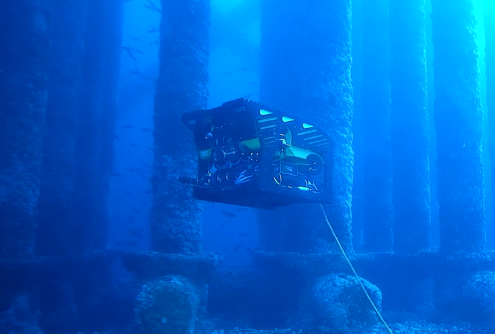DeepOcean has mobilized its first Autonomous Inspection Drone (AID), said to be able to unlock substantial cost savings for offshore wind and oil & gas operators.

Source: DeepOcean
The project is a strategic partnership between DeepOcean, Argus Remote Systems and Vaarst, with industry guidance, support and funding from AkerBP to bring the platform to market.
This first AID was mobilized on board the Edda Fauna subsea inspection, maintenance and repair (IMR) and remotely operated vehicle (ROV) support vessel, which is on a long-term charter with DeepOcean.
Remota AS, the joint venture between DeepOcean, Solstad Offshore and Østensjø Group, is enabling offshore operations to be performed from onshore through digitalized control systems. Deepocean is running the AID from the Remota control center (ROC).
The plan is to conduct offshore trials in the coming months for utilizing the AID under one of DeepOcean’s annual inspection campaigns for an operator on the Norwegian continental shelf (NCS).
“A rapidly growing amount of subsea infrastructure is placed on the seabed within both the offshore renewables and oil and gas industries. This equipment needs to be inspected regularly,” said Craig Cameron, Technology Manager at DeepOcean.
“We have developed the AID to increase efficiency and accuracy when collecting inspection data. It has the potential to substantially reduce the cost, time and environmental footprint that is normally associated with subsea inspection work.”
The AID is based on a Rover MK2 ROV from Argus Remote Systems, while Argus is responsible for the AID platform and navigation algorithm.
DeepOcean is in charge of the digital twin platform, mission planner software, and live view of the AID in operation, while Vaarst is responsible for the machine vision camera Subslam 2x for autonomous navigation and data collection.
The AID is 1.25 meters long, weighs 320 kilograms in air, and can operate in water depths down to 3,000 meters.
The inertial navigation system selected from Sonardyne is the Sprint Navigator mini 4K. Live imaging sonar with obstacle tracking and avoidance is from the Norbit WBMS FLS.
According to DeepOcean, the AID can perform pre-programmed inspections of all subsea assets, which means that significant value can be created for operators of offshore energy assets when the same inspection scope can be repeated year-on-year.
“We look forward to proving that the AID allows autonomous surveys to be carried out, enabling us to collect data in a smarter way, and gain better support for comparisons and changes over time on subsea equipment. Irrespective of the AID launch platform, we believe that the combination of AID and digital twins for subsea inspection work can save operators of offshore assets a substantial amount of time and money,” Cameron concluded.